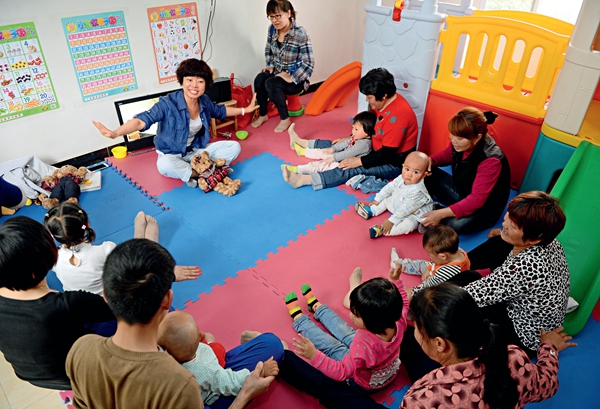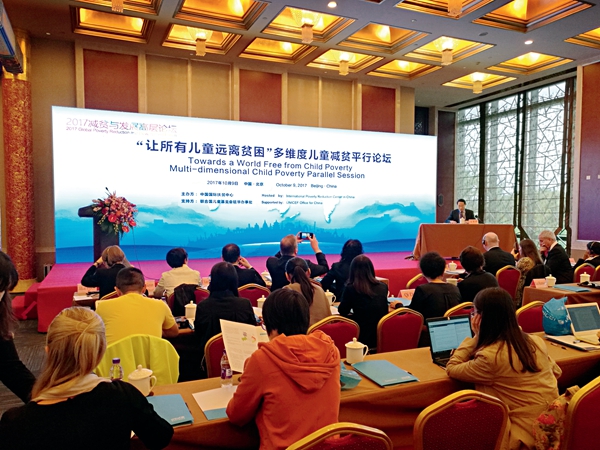By staff reporter ZHOU LIN
By staff reporter ZHOU LIN
EXPERIENCING poverty in childhood has a profound impact on the growth of children, as their physical and mental health shape their futures. Reducing child poverty, especially with a focus on children living in rural areas, and promoting their healthy growth and overall development, is an important way not only to break the inter-generational cycle of poverty, but also to implement the long-term poverty alleviation strategy, achieve the UN Sustainable Development Goals, and promote social development and social equity,” said Dr. Zuo Changsheng, director-general of the International Poverty Reduction Center in China (IPRCC) at the parallel session of 2017 Global Poverty Reduction and Development Forum with the theme of “Towards a World Free from Child Poverty: Multidimensional Child Poverty,” co-organized by IPRCC and UNICEF.
Poverty Threatens Children’s Lives
Around the world, children are over-represented in populations living in extreme poverty. The effects of poverty on young children are often irreversible because they can affect a kid’s physical, mental, and emotional development. For example, if children do not get adequate nutrition in their first two years, they can become stunted for life.

UNICEF’s statistics show that in China’s remote rural areas, the living expenses of 15 million children is less than RMB eight per day. Over one third of children are left behind as their parents seek work in more developed areas. The mortality rate of rural children under five years old is double that in urban areas, and the growth retardation rate triples. The gross admission rate of preschool education is also lower in rural China.
The UN Sustainable Development Goals proposed to halve the population of children mired in poverty by 2030, and eventually end poverty in all forms everywhere.
Putting children first in national poverty alleviation efforts is the most effective way of breaking the inter-generational cycle of poverty, supporting children to grow and develop to their fullest potential, and driving national development and growth.
In 2011, in order to meet the needs of child development and break the transition of poverty from one generation to the next, the Chinese government issued the National Program for Child Development (2011-2020), proposing major targets and policies in five areas: health, education, welfare, social environment, and legal protection. At the same time, the Rural Poverty Alleviation and Development Program (2011-2020) clearly stipulates the importance of rural child development for poverty alleviation and requires government at all levels to give priority to women and children.
Developing Children’s Fullest Potential
Throughout the parallel session, experts from the government, non-profit, private, and academic sectors as well as international organizations discussed the different dimensions of ending child poverty and its significance, and shared the experience of establishing Early Childhood Development (ECD) centers in Hubei Province.
The mountainous region in Central China’s Hubei Province is gloomy and cold in early winter. In a small activity room of Wangjiaping Village, eight children and their parents sit together, with books and toys stacked in one corner.

Since 2012, with UNICEF China’s assistance, the All-China Women’s Federation has set up community-based ECD centers in poor rural areas affected by urban migration in Hubei, Hunan, and other provinces. Wangjiaping of Wufeng County is a pilot village. UNICEF has supplied it with books, toys, desks, chairs, and outdoor facilities for children. Children can play in the ECD center five days a week. Parents can engage with them under the guidance of volunteers. Regular visits by ECD experts also teach parents better ways to raise their children.
Lu Hongfei, 28, arrives at this community service center with her three-year-old daughter after walking for half an hour. It was the first time for the girl to play at the center. In the last seven years, Lu and her husband ran a store selling electronics in Hangzhou, Zhejiang Province in east China. Lu brought their elder daughter back to their hometown last month and recently gave birth to the second daughter.
“A one-year early education program costs thousands in Hangzhou, and we can’t afford it,” Lu said. “I never thought the toys and picture books here would be the same as those in the city – and free. Rural children can now have the same opportunity as children in big cities.”
Lingbao Village, in the suburbs of Hubei’s Yichang City, is home to another pilot ECD center. Since 2014, the center has given 73 children under three and their families ECD support.
Liao Xinyi was born in August 2014, the same year Lingbao’s ECD center was established. Xinyi’s mother, Lian Lanlan, has been taking her to the service center every week to listen to music, read books, and play with other children since she was just a few months old. Lively Xinyi now can sing the English alphabet and loves watching cartoons.
Renovation and refurnishing for the center is undergoing in Lingbao Village. Village head Wang Kangjun said that the village has invested RMB 300,000 to expand it. The activity room has been renovated from an area of 20 square meters to 400 square meters, so all children in the village will be able to enjoy it with their parents. The building materials are also environment-friendly.
“The ECD pilot project also drives improvement of infrastructure in the village,” said Wang Kangjun. “To encourage villagers to bring their children to the center, the local government invested RMB 15 million last year in paving a new road as well as planting trees.”
In 2016, 26 new pilot sites have been added to UNICEF’s Early Child Development Community and Family Support Program. By 2020, as many as 146 ECD centers are expected to be built in China.
Education officer of UNICEF China Zhao Qi said, “ECD is about the omni-development – physical, social, emotional, cognitive thinking, and language progress of each young individual. There is an early window of opportunity to provide the nourishment, simulation, vaccinations, and security that children need for their brains to fully develop and to help fulfill their own potential.”
If the Early Child Development Service Program can be replicated and developed in a sustainable manner, the model and experience gained from these pilot centers will provide a basis for the government to develop and implement relevant policies, which will improve the childhood experience for more children.
No Child Left Behind
In 2015, a child poverty analysis was co-conducted by IPRCC and UNICEF in four areas of Hubei Province, identifying eight dimensions of deprivation – nutrition, health, education, information, water, sanitation, housing, and protection – and uniquely gathered these experiences of children. Findings showed that many children suffer from at least one deprivation, with the greatest deprivations being access to sanitation facilities, childhood nutrition, the enrollment rate of preschool children, and access to safe drinking water. We need to understand every cause of poverty before we can target our interventions to those who need them most.
“About 40 million people are still in poverty in China. In order to solve the problems they face we need to identify the causes,” said Rana Flowers, UNICEF Representative to China. She pointed out that local governments need to be empowered to collect data that reveal all the different dimensions of poverty. This includes access to good food, and good quality schools, amongst other things.
“Once policy makers have a grip on each of the issues facing families, they can systematically address them, thus ending poverty for every child,” Flowers said.